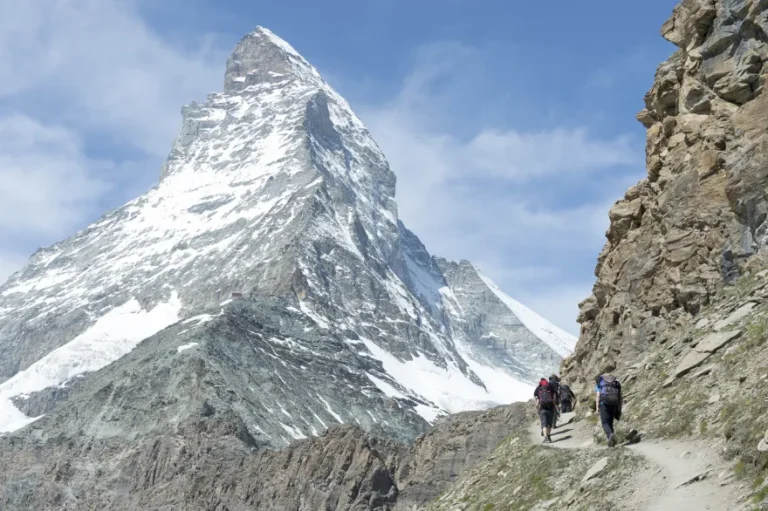The Matterhorn, an iconic pyramid of rock and ice, towers over the Swiss Alps with an allure that has captivated climbers for generations. However, its beauty belies the dangers that lurk on its slopes. Recently, the mountain was again the site of tragedy, as another climber lost their life in an attempt to conquer its formidable peak.
On that fateful morning, the sun rose over Zermatt, casting golden rays on the pristine snow. The air was crisp, invigorating, and the sky was a brilliant blue—perfect conditions for a climb. Enthusiasts from around the world had gathered in the small alpine village, all sharing the same dream: to stand atop one of the most photographed mountains in the world. Among them was an experienced climber, a seasoned adventurer with numerous ascents under their belt, eager to take on the Matterhorn.
As the climber set out, they were filled with a mix of excitement and respect for the mountain. The Matterhorn, often referred to as “the mountain of mountains,” is not only a breathtaking sight but also a formidable challenge. Its steep, icy faces and unpredictable weather have claimed many lives, and those who attempt its ascent must be well-prepared. This climber, however, was confident. They had trained for months, meticulously planning every detail of the ascent.
As the climber began the ascent, they moved with determination, traversing rocky ledges and navigating through ice fields. Each step was measured, each hold carefully chosen. Yet, as the altitude increased, so did the challenges. The air grew thinner, and the weather began to shift unexpectedly. What started as a clear day turned ominous, clouds swirling in with a sudden ferocity. The forecast had warned of potential storms, but many climbers, driven by ambition, often underestimate the mountain’s capricious nature.
As the climber reached one of the more treacherous sections known as the Hörnli Ridge, the wind picked up, howling around them. Visibility dropped sharply, and the once-familiar route became obscured by swirling snow. Despite their experience, the climber found themselves disoriented, the line between safety and peril blurring in the whiteout conditions. In these moments, the mountain demands respect and can punish even the slightest lapse in judgment.
Communication became difficult as the weather worsened. Fellow climbers, also caught in the storm, attempted to make their way down, but the harsh conditions made it nearly impossible to gauge the safest route. The climber pressed on, driven by a mix of determination and an unwillingness to turn back. It was a decision that would prove fateful.
Just moments later, in a sudden slip, the climber lost their footing on a patch of ice. In that instant, time seemed to stretch as they fell, the world around them becoming a blur of white. Fellow climbers looked on in horror, realizing the peril that had just unfolded before their eyes. Efforts to reach the fallen climber were complicated by the worsening conditions; rescuers could only watch and hope as the storm raged on.
As the weather finally began to subside hours later, rescue teams initiated a recovery operation. They braved the now-treacherous terrain, battling against fatigue and uncertainty. The search was grueling; the mountain had shifted with the storm, concealing the climber beneath a layer of fresh snow. After what felt like an eternity, the team found the climber, but the reality of the situation became painfully clear: despite their skill and experience, the mountain had claimed another life.
The news of the tragedy reverberated through Zermatt and beyond. The Matterhorn, a symbol of adventure and challenge, now stood as a stark reminder of the thin line between triumph and tragedy. Stories poured in from fellow climbers and locals, each recounting their experiences and the respect the mountain commands. For every successful ascent, there are countless tales of struggle and loss, of climbers who pushed their limits only to be met with the unforgiving reality of nature’s whims.
In the aftermath, the climbing community grappled with the loss. Vigils were held, and conversations around safety practices intensified. Many recalled the fallen climber’s dedication to the sport, their passion for the mountains, and the impact they had on those around them. The tragedy served as a poignant reminder that while ambition and determination drive climbers to seek the summit, it is imperative to recognize the inherent risks involved.
As the seasons changed and winter approached, the Matterhorn continued to loom large, its snow-capped peak a testament to both beauty and danger. Climbers would still come, drawn by the challenge it presents. But with each ascent, they would carry with them the memory of those who had come before, reminding themselves that on this majestic mountain, respect is not just an option—it is a necessity.


